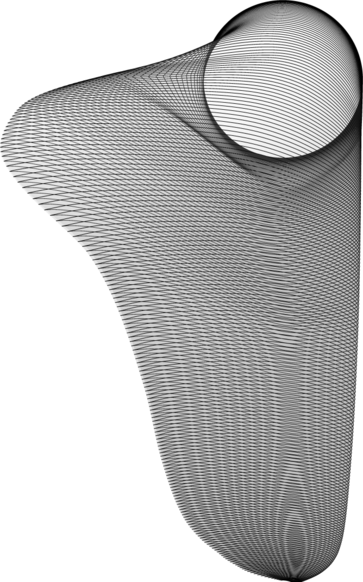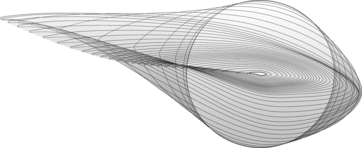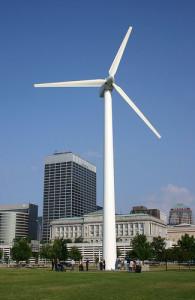Whenever I drive past the Great Lakes Science Center on my way into Cleveland, I pass the giant wind turbine installed outside the museum. I’ve seen it so many times that the 150-foot turbine barely registers anymore, except on particularly windy days when its rotors are whipping around at an intimidating speed. It’s apparently one of the most-viewed wind turbines in the world, oddly, due to its location in front of the often-filmed Rock and Roll Hall of Fame, the Cleveland Browns’ Stadium, and the Science Center. Hey, another thing I can brag about when trying to get my friends to visit me in Cleveland! “Want to see one of the world’s most famous wind turbines? I thought so!”
In all seriousness, it is a point of pride for me that my hometown has become very conscientious about sustainability over the past several years. Wind power is one of the largest areas of research into renewable energy, and so it makes me happy to see not only the massive Science Center turbine but the other, less-famous ones scattered around Northeast Ohio. If you want to talk about serious wind energy research, though, you’ll want to check out Sandia National Laboratories. The US Department of Energy Contractor carries out critical research in the areas of national security, defense, energy and climate issues, and their Scaled Wind Farm Technology (SWiFT) facility, located at Texas Tech University in Lubbock, Texas, uses top-of-the-line technology for its research into improving wind energy.
 Much of the research at SWiFT is focused on what seems like minutia, but what is actually critically important for the function of wind power facilities – for example, the study of wakes. As the SWiFT website states:
Much of the research at SWiFT is focused on what seems like minutia, but what is actually critically important for the function of wind power facilities – for example, the study of wakes. As the SWiFT website states:
“It is well known that large amounts of wind energy are not effectively harvested in large wind farms because the turbines ‘shadow’ each other and reduce the output of the turbines located in their wake. The wakes also produce increased turbulence and uneven loading on the shadowed turbines, increasing fatigue issues that eventually affect a wind farm’s longevity and reliability.”
 In other words, wind turbines installed in groups interfere with each other’s ability to generate power – but if wind energy is to work on a large scale, wind farms are a necessity. Research facilities like SWiFT are attempting to find a way to design the rotors of wind turbines so that they can still produce power, but won’t generate wakes that will interfere with the effectiveness of the turbines near them.
In other words, wind turbines installed in groups interfere with each other’s ability to generate power – but if wind energy is to work on a large scale, wind farms are a necessity. Research facilities like SWiFT are attempting to find a way to design the rotors of wind turbines so that they can still produce power, but won’t generate wakes that will interfere with the effectiveness of the turbines near them. Like so much other sustainable technology, wind turbines lend themselves well to 3D printing, and 3D printing will be used to produce the new, aerodynamic blade for the National Rotor Testbed (NRT), which will be used to replicate the wakes generated by utility-scale rotors in a typical wind farm. The NRT will be installed at the SWiFT facility, where researchers will collect data such as wind measurements in hopes of developing potential solutions to wake interference issues.
 The NRT blades will also demonstrate that 3D printing is an effective manufacturing method for wind turbine rotors. The manufacture of the blades is expected to conclude sometime this summer, with testing to follow. The aerodynamic design was completed only a few days ago, and several organizations, including Oak Ridge National Laboratory, TPI Composites, and Wetzel Engineering will be involved in the design and printing of the molds. Initial structural testing will take place at the National Renewable Energy Laboratory. It’s amazing to think how much work, and how many people, are involved in the creation of one component – but depending on what comes from the testing, that one component could play a major role in where our energy comes from in the future. What do you think of using wind as an energy source? Discuss in the 3D Printed Turbine Rotor Blade forum over at 3DPB.com.
The NRT blades will also demonstrate that 3D printing is an effective manufacturing method for wind turbine rotors. The manufacture of the blades is expected to conclude sometime this summer, with testing to follow. The aerodynamic design was completed only a few days ago, and several organizations, including Oak Ridge National Laboratory, TPI Composites, and Wetzel Engineering will be involved in the design and printing of the molds. Initial structural testing will take place at the National Renewable Energy Laboratory. It’s amazing to think how much work, and how many people, are involved in the creation of one component – but depending on what comes from the testing, that one component could play a major role in where our energy comes from in the future. What do you think of using wind as an energy source? Discuss in the 3D Printed Turbine Rotor Blade forum over at 3DPB.com.
Subscribe to Our Email Newsletter
Stay up-to-date on all the latest news from the 3D printing industry and receive information and offers from third party vendors.
You May Also Like
Profiling a Construction 3D Printing Pioneer: US Army Corps of Engineers’ Megan Kreiger
The world of construction 3D printing is still so new that the true experts can probably be counted on two hands. Among them is Megan Kreiger, Portfolio Manager of Additive...
US Army Corps of Engineers Taps Lincoln Electric & Eaton for Largest 3D Printed US Civil Works Part
The Soo Locks sit on the US-Canadian border, enabling maritime travel between Lake Superior and Lake Huron, from which ships can reach the rest of the Great Lakes. Crafts carrying...
Construction 3D Printing CEO Reflects on Being Female in Construction
Natalie Wadley, CEO of ChangeMaker3D, could hear the words of her daughter sitting next to her resounding in her head. “Mum, MUM, you’ve won!” Wadley had just won the prestigious...
1Print to Commercialize 3D Printed Coastal Resilience Solutions
1Print, a company that specializes in deploying additive construction (AC) for infrastructure projects, has entered an agreement with the University of Miami (UM) to accelerate commercialization of the SEAHIVE shoreline...































